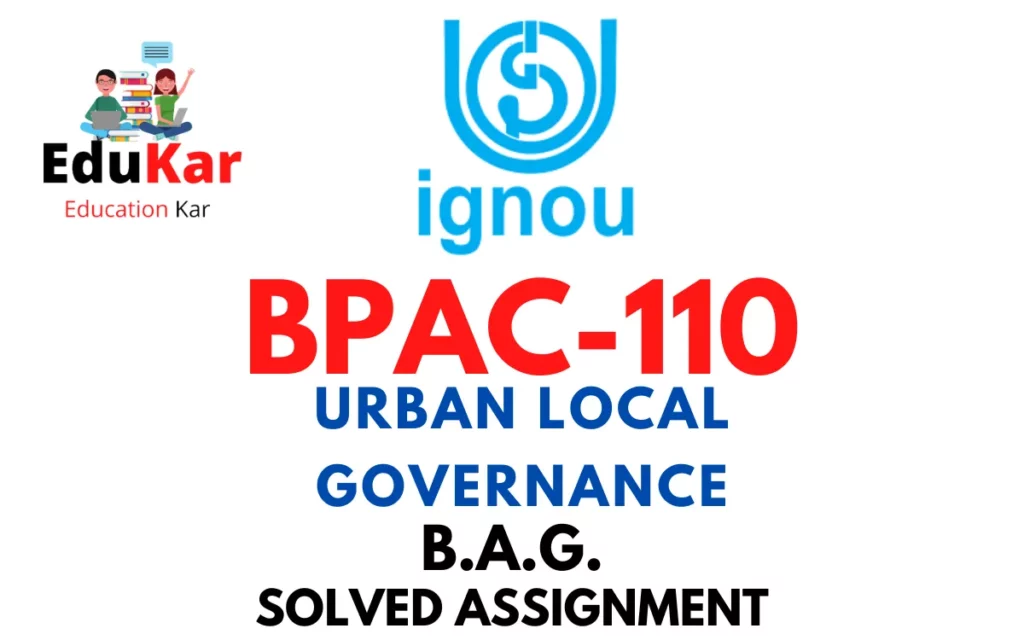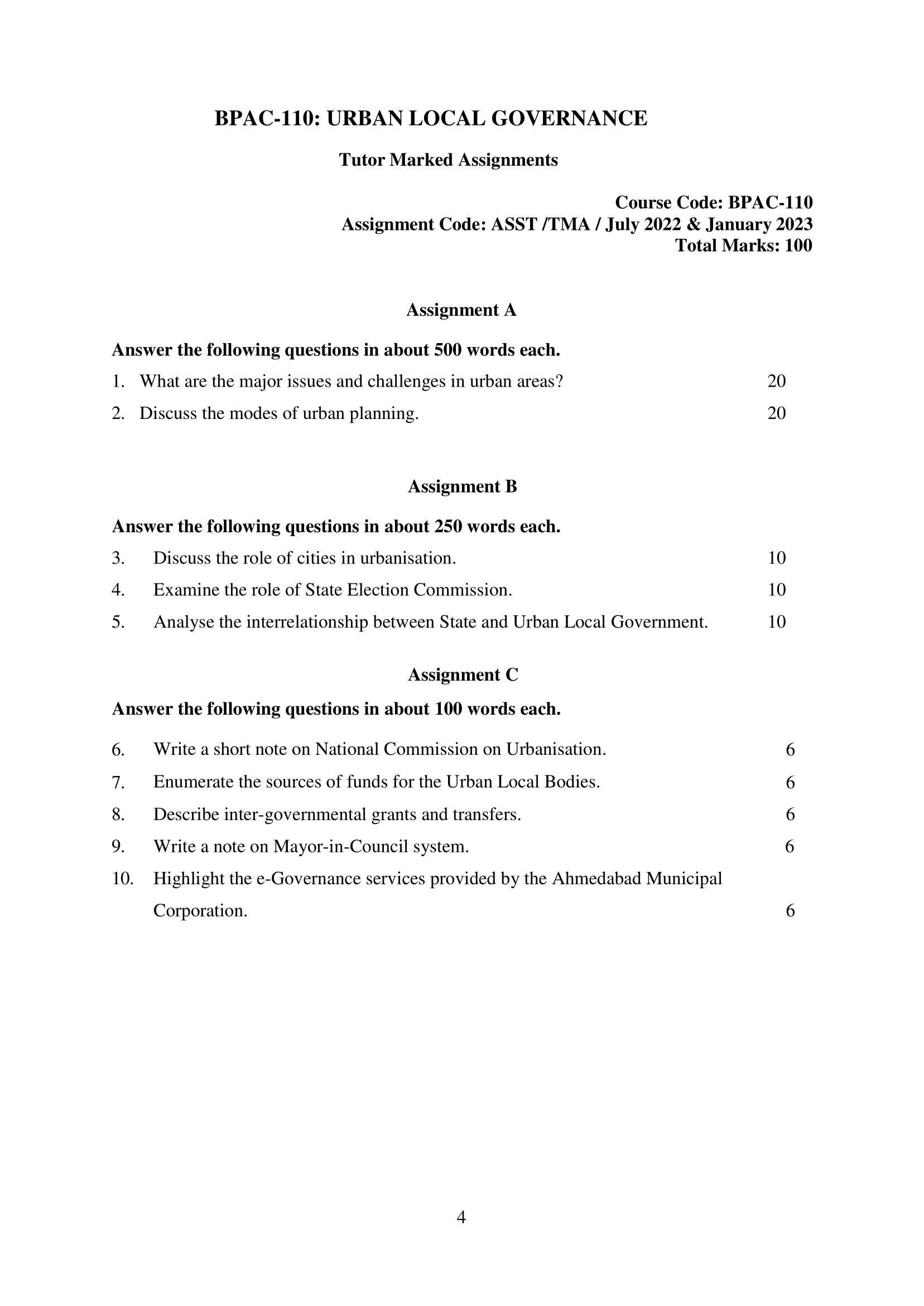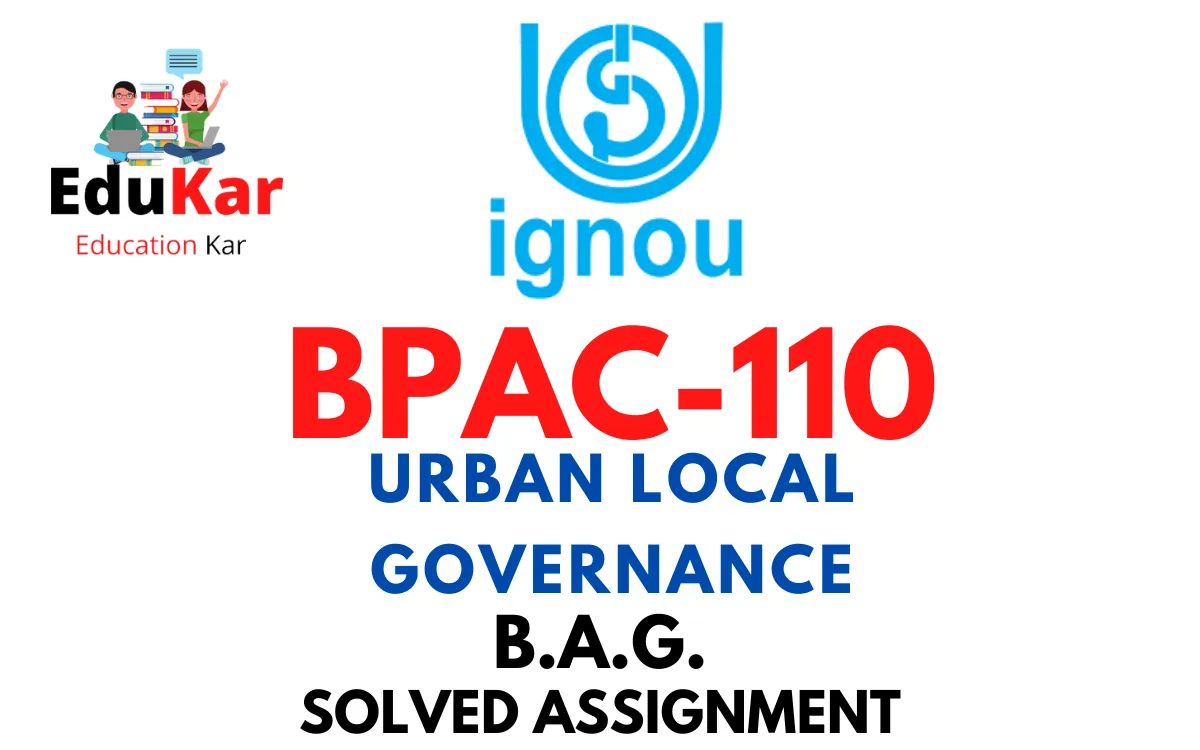
| Title | BPAC-110: IGNOU BAG Solved Assignment 2022-2023 |
| University | IGNOU |
| Degree | Bachelor Degree Programme |
| Course Code | BPAC-110 |
| Course Name | URBAN LOCAL GOVERNANCE |
| Programme Name | Bachelor of Arts (General) |
| Programme Code | BAG |
| Total Marks | 100 |
| Year | 2022-2023 |
| Language | English |
| Assignment Code | ASST /TMA / July 2022 & January 2023 |
| Assignment PDF | Click Here |
| Last Date for Submission of Assignment: | For June Examination: 31st April For December Examination: 30th September |

Assignment A
Answer the following questions in about 500 words each.
1. What are the major issues and challenges in urban areas?
Ans: Urban areas face a multitude of issues and challenges that can impact the quality of life of their residents. In this response, I will highlight some of the major issues and challenges in urban areas.
- Housing: One of the most significant issues in urban areas is affordable housing. With urbanization, demand for housing has increased, driving up housing prices. As a result, many residents cannot afford to rent or buy a home, and they may be forced to live in substandard or overcrowded conditions.
- Transportation: Urban areas often experience traffic congestion due to high levels of automobile use. Traffic congestion can lead to increased travel times, air pollution, and negative health outcomes. Furthermore, lack of efficient and affordable public transportation options can make it difficult for people to access employment and essential services.
- Crime and safety: Urban areas are often associated with higher levels of crime and safety concerns. High levels of poverty, unemployment, and social inequality can contribute to an increase in criminal activities. Inadequate lighting, poor street design, and lack of police presence can make urban areas more dangerous, especially at night.
- Environmental challenges: Urban areas face a range of environmental challenges such as air pollution, water pollution, and waste management. Industrial activity, transportation, and construction are among the major contributors to environmental problems in urban areas. These challenges can have a significant impact on public health and the natural environment.
- Social inequality: Urban areas are often characterized by significant social and economic inequality. This can lead to unequal access to education, healthcare, and employment opportunities. Marginalized communities in urban areas often face discrimination and exclusion, which can further exacerbate social inequality.
- Aging infrastructure: Many urban areas face aging infrastructure, which can lead to issues such as water and sewer line breaks, power outages, and transportation disruptions. This can lead to significant economic losses and impact the quality of life of residents.
- Public health: Urban areas often face a range of public health challenges, such as infectious diseases, poor air quality, and food insecurity. Overcrowded living conditions, inadequate sanitation, and lack of access to healthcare can further compound these health challenges.
2. Discuss the modes of urban planning.
Ans: Urban planning is the process of designing, managing, and developing the physical, social, and economic aspects of urban areas. The objective of urban planning is to create livable and sustainable communities that meet the needs of residents. There are several modes of urban planning, each with their own strengths and weaknesses. In this response, I will discuss some of the most common modes of urban planning.
- Comprehensive Planning: Comprehensive planning is a mode of urban planning that considers all aspects of a city’s development. It focuses on long-term planning and includes the participation of all stakeholders. Comprehensive planning is beneficial because it considers the physical, social, and economic aspects of a city’s development. However, it can be a time-consuming and costly process.
- Incremental Planning: Incremental planning is a mode of urban planning that focuses on small, gradual changes. It is often used in older urban areas, where it is more challenging to make significant changes to the physical environment. Incremental planning is beneficial because it can be more cost-effective and it can involve community members in the planning process. However, it may not address larger systemic issues.
- Strategic Planning: Strategic planning is a mode of urban planning that focuses on the long-term goals of a city. It involves identifying the major issues and challenges facing a city and creating strategies to address them. Strategic planning is beneficial because it provides a clear vision for a city’s future. However, it may not be as effective in responding to short-term issues.
- Advocacy Planning: Advocacy planning is a mode of urban planning that focuses on advocating for the needs of marginalized communities. It involves working with community members to identify their needs and advocating for policies and programs that meet those needs. Advocacy planning is beneficial because it ensures that the needs of marginalized communities are prioritized. However, it may not address broader issues facing a city.
- Participatory Planning: Participatory planning is a mode of urban planning that involves active participation from community members. It aims to ensure that residents have a say in the planning process and that their needs are addressed. Participatory planning is beneficial because it can result in more inclusive and equitable planning. However, it can be time-consuming and may not involve all community members.
- Land Use Planning: Land use planning is a mode of urban planning that focuses on how land is used in a city. It involves identifying the best uses for different areas of land, such as residential, commercial, or industrial. Land use planning is beneficial because it can ensure that land is used in the most efficient and effective way. However, it may not address broader issues facing a city.
Assignment B
Answer the following questions in about 250 words each.
3. Discuss the role of cities in urbanisation.
Ans: Cities play a crucial role in urbanization, which refers to the process of transformation from a rural and agricultural-based society to an urban and industrial-based one. Urbanization is a global phenomenon that has been accelerating rapidly over the past century, and cities are at the heart of this process. There are several roles that cities play in urbanization:
- Economic growth: Cities are the engines of economic growth in modern societies. They are centers of innovation, investment, and entrepreneurship, and provide a platform for the development of new technologies and industries. They are also magnets for human capital, attracting talented people who can contribute to the growth of businesses and industries. In turn, economic growth leads to improved standards of living, better access to services, and increased job opportunities.
- Social integration: Cities are melting pots of different cultures, religions, and ethnicities. They provide a platform for people from different backgrounds to interact, share ideas, and work together. This helps to break down social barriers and promote social integration, leading to a more cohesive and harmonious society.
- Environmental sustainability: Cities have a critical role to play in promoting environmental sustainability. They are centers of innovation and experimentation, and can develop new technologies and solutions to environmental challenges. Cities can also promote sustainable lifestyles, such as public transportation, renewable energy, and green building design.
- Political power: Cities are often centers of political power, with many national governments based in capital cities. Cities also have their own political structures and can be powerful actors in their own right. They can influence national and international policy, and provide a platform for political activism and social change.
4. Examine the role of State Election Commission.
Ans: The State Election Commission (SEC) is an independent constitutional authority responsible for conducting free and fair elections to local self-government bodies, including municipalities, panchayats, and urban local bodies. The SEC is created under Article 243K of the Constitution of India and is headed by a State Election Commissioner appointed by the Governor of the state.
The primary role of the State Election Commission is to ensure that the electoral process is free and fair, transparent, and accountable. This includes the preparation of electoral rolls, the conduct of elections, and the declaration of results. The Commission also has the power to delimit constituencies, reserve seats for marginalized communities, and oversee the disqualification of candidates for electoral malpractices.
Some of the key functions and responsibilities of the State Election Commission include:
- Conducting elections: The State Election Commission is responsible for conducting elections to local self-government bodies in a free, fair, and transparent manner. This includes preparing electoral rolls, issuing voter ID cards, and conducting polling.
- Delimitation of constituencies: The Commission is responsible for the delimitation of constituencies for local self-government bodies, ensuring that each constituency has a roughly equal number of voters and that seats are reserved for marginalized communities.
- Overseeing the election process: The State Election Commission is responsible for overseeing the election process, including the deployment of polling officers, the preparation of polling stations, the counting of votes, and the declaration of results.
- Monitoring political parties and candidates: The Commission monitors political parties and candidates to ensure that they comply with the election code of conduct and do not engage in electoral malpractices.
- Adjudicating disputes: The State Election Commission has the power to adjudicate disputes arising from the electoral process, including disputes over voter lists, polling stations, and the counting of votes.
5. Analyse the interrelationship between State and Urban Local Government.
Ans: The relationship between the state and urban local government is one of interdependence, with each level of government having its own distinct responsibilities and roles. Urban local government refers to municipal corporations, municipal councils, and other local government bodies responsible for providing basic services and infrastructure to urban areas. The state government, on the other hand, is responsible for policymaking, resource allocation, and oversight of local government bodies.
The interrelationship between state and urban local government can be analyzed in the following ways:
- Administrative control: The state government has administrative control over urban local government bodies. This includes the power to create, abolish, or modify local government bodies, and to appoint and remove officials from these bodies. The state government also provides financial assistance to local government bodies, and has the power to impose taxes and fees on them.
- Legislative control: The state government has the power to legislate on matters related to urban local government, including the functions and powers of local government bodies, and the allocation of financial resources to them. However, the state government must also consult with and seek the approval of local government bodies before making any major changes to their structure or functions.
- Coordination and cooperation: State and urban local government bodies need to coordinate and cooperate with each other to effectively deliver public services and infrastructure. This includes coordination in areas such as land use planning, infrastructure development, and service delivery. Local government bodies need to work with state government agencies and departments to ensure that services are delivered efficiently and effectively.
- Accountability: Both the state and urban local government are accountable to their constituents. Local government bodies are accountable to the people they serve, while the state government is accountable to both local government bodies and the people of the state. The state government has a responsibility to monitor and supervise the functioning of local government bodies, and to ensure that they are delivering services and infrastructure effectively and efficiently.
Assignment C
Answer the following questions in about 100 words each.
6. Write a short note on National Commission on Urbanisation.
Ans: The National Commission on Urbanisation (NCU) was established in India in 1985 to review the existing policies and programmes related to urbanisation and to provide recommendations for future policies. The Commission was chaired by the then Deputy Chairman of the Planning Commission, Dr V. Krishnamurthy. The NCU submitted its report in 1988, which highlighted the need for a comprehensive and integrated approach to urbanisation. The report recommended the establishment of a National Urbanisation Policy, the creation of a National Urban Development Authority, and the devolution of more power to local governments. The recommendations of the NCU report have been used as a basis for many of the urban development policies and programmes in India.
7. Enumerate the sources of funds for the Urban Local Bodies.
Ans: Urban Local Bodies (ULBs) are responsible for providing various services and infrastructure in urban areas, such as water supply, sanitation, solid waste management, roads, and street lighting. ULBs require funds to carry out their functions effectively. There are several sources of funds for ULBs, which can be broadly categorized into the following:
- Own Source Revenue: This refers to revenue generated by ULBs through their own sources, such as taxes, fees, charges, and other levies. Some of the commonly used taxes and fees include property tax, water and sewerage charges, trade license fees, and advertisement fees. These revenues are critical for ULBs as they provide a stable and predictable source of income.
- Central and State Government Grants: The central and state governments provide grants to ULBs for various development projects and programs. The grants can be in the form of specific-purpose grants or general-purpose grants. The specific-purpose grants are provided for a specific project or program, while general-purpose grants are provided for overall urban development.
- Loans and Borrowings: ULBs can also raise funds through loans and borrowings from financial institutions such as banks and other lending agencies. However, they need to be cautious about taking on debt, as it can lead to financial instability and debt servicing issues.
- Public-Private Partnerships: ULBs can also engage in public-private partnerships (PPPs) to fund and manage urban services and infrastructure. PPPs can help ULBs leverage private sector expertise and capital to deliver services and infrastructure more efficiently.
- Capital Markets: Some ULBs can also raise funds through the capital markets by issuing municipal bonds. This is a relatively new financing option for ULBs in India, and only a few ULBs have been successful in issuing bonds so far.
8. Describe inter-governmental grants and transfers.
Ans: Intergovernmental grants and transfers are funds that are transferred from one level of government to another to finance specific programs, projects, or activities. In many countries, intergovernmental grants and transfers are an important source of revenue for subnational governments, including cities and municipalities.
There are several types of intergovernmental grants and transfers. These include:
- Block Grants: Block grants are grants that are provided to subnational governments for a specific purpose, such as education, healthcare, or social services. These grants provide subnational governments with a certain amount of flexibility in how they use the funds.
- Formula Grants: Formula grants are grants that are provided to subnational governments based on a formula that takes into account factors such as population, income, or other demographic or economic indicators. Formula grants are usually distributed among subnational governments in a more equal manner than block grants.
- Categorical Grants: Categorical grants are grants that are provided to subnational governments for a specific program or project, such as a transportation project or a housing program. Categorical grants are often more restrictive than block grants, as they usually come with specific requirements and conditions.
- Revenue Sharing: Revenue sharing is a mechanism by which the central government shares its tax revenues with subnational governments. Revenue sharing is often used to support subnational governments in low-income areas, as it provides them with additional resources to finance their programs and services.
- Special Purpose Grants: Special purpose grants are grants that are provided to subnational governments for specific purposes, such as disaster relief or infrastructure development. Special purpose grants are usually provided on an ad-hoc basis, as they are designed to address specific needs or emergencies.
Intergovernmental grants and transfers can play an important role in supporting subnational governments in delivering services and programs to their citizens. They can also help to promote economic development and reduce inequalities among regions. However, it is important to ensure that intergovernmental grants and transfers are used effectively and efficiently, and that they are distributed in a fair and transparent manner.
9. Write a note on Mayor-in-Council system.
Ans: The Mayor-in-Council system is a form of municipal governance in which the Mayor is the executive head of the municipal corporation and is assisted by a council of elected representatives. In this system, the Mayor is elected by the people, and the council members are elected through a popular vote. The Mayor and the council members together form the executive committee of the municipal corporation.
Under the Mayor-in-Council system, the Mayor has the power to preside over the meetings of the council, and is responsible for the day-to-day administration of the municipal corporation. The council members act as advisors to the Mayor and assist him in making policy decisions related to the functioning of the municipal corporation. The Mayor and the council members work together to ensure the effective delivery of civic services to citizens and to promote the development of the municipality.
The Mayor-in-Council system is prevalent in several states in India, including West Bengal, where it was introduced in the early 1990s. The system is designed to ensure that the elected representatives of the people have a say in the administration of the municipality, and that the Mayor has the support of the council members in implementing policies and programs.
The Mayor-in-Council system has its advantages and disadvantages. One advantage is that it allows for greater participation by elected representatives in the administration of the municipality. The council members can provide valuable input and advice to the Mayor, and can act as a check on the power of the Mayor. However, the system can also lead to conflicts between the Mayor and the council members, and can make decision-making more cumbersome and time-consuming.
10. Highlight the e-Governance services provided by the Ahmedabad Municipal Corporation.
Ans: The Ahmedabad Municipal Corporation (AMC) provides a range of e-Governance services to citizens to make it easier to access municipal services and information. Some of the e-Governance services provided by the AMC include:
- Online payment of property taxes and water bills
- Online application for birth and death certificates
- Online grievance redressal mechanism for complaints related to civic amenities
- Online booking of community halls, gardens, and sports facilities
- Online building plan approval and permission application
- Mobile app for accessing services and information on the go.
These e-Governance services offered by AMC are helping to streamline the delivery of municipal services and reduce the time and effort required for citizens to access them. By leveraging technology, AMC is improving transparency and accountability, and promoting efficient and effective governance.
How to Download BPAC-110 Solved Assignment?
You can download it from the www.edukar.in, they have a big database for all the IGNOU solved assignments.
Is the BPAC-110 Solved Assignment Free?
Yes this is absolutely free to download the solved assignment from www.edukar.in
What is the last submission date for BPAC-110 Solved Assignment?
For June Examination: 31st April, For December Examination: 30th October





